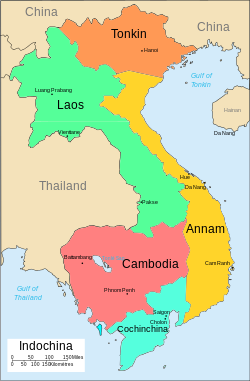Annam (French colony)
| Protectorate of Annam | ||||||||||||||
| Protectorat d'Annam Trung Kỳ |
||||||||||||||
| Protectorate of France; constituent territory of French Indochina | ||||||||||||||
|
||||||||||||||
|
Annam is located in central Vietnam, shaded yellow
|
||||||||||||||
| Capital | Huế | |||||||||||||
| Languages | Cham, Bahnar, Rade, Jarai, Stieng, Mnong, Koho, Chinese, French, Vietnamese | |||||||||||||
| Religion | Hinduism, Islam, Mahayana Buddhism, Confucianism, Animism | |||||||||||||
| Political structure | Monarchy, Protectorate | |||||||||||||
| History | ||||||||||||||
| • | Established | 1883 | ||||||||||||
| • | Disestablished | 1948 | ||||||||||||
| Currency | French Indochinese piastre | |||||||||||||
|
||||||||||||||
| Today part of |
|
|||||||||||||
Annam (Vietnamese: An Nam or Trung Kỳ, alternate spelling: ) was a French protectorate encompassing the central region of Vietnam. Before the protectorate's establishment, the name Annam was used in the West to refer to Vietnam as a whole. Vietnamese were referred to as "Annamites." The protectorate of Annam became in 1887 a part of French Indochina. Two other Vietnamese regions, Cochinchina (Nam Kỳ) in the South and Tonkin (Bắc Kỳ) in the North, were also units of French Indochina. The region had a dual system of French and Vietnamese administration. The Nguyễn Dynasty still nominally ruled Annam, with a puppet emperor residing in Huế. In 1948, the protectorate was merged in the Provisional Central Government of Vietnam, which was replaced the next year by the newly established State of Vietnam. The region was divided between communist North Vietnam and anti-communist South Vietnam under the terms of the Geneva Accord of 1954.
...
Wikipedia



